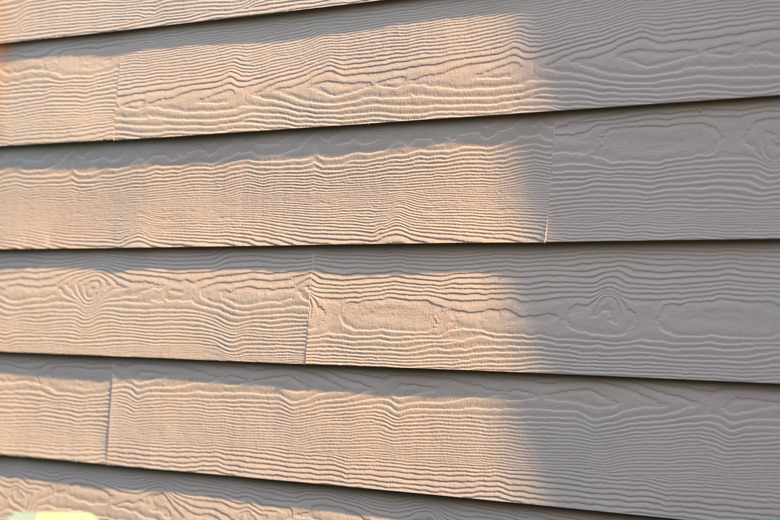Fiber Cement Siding Vs. Hardiplank Siding
If you're building a house or putting new siding on one, your exterior options aren't limited to vinyl and wood. Vinyl is a form of pliable plastic. Wood needs to be repainted every five years or so. But fiber-cement siding — of which Hardieplank is a leading brand — has the timeless look of wood and the carefree nature of vinyl, all packaged in a durable, long-lasting siding.
HardiePlank Siding Origins
HardiePlank Siding Origins
HardiePlank Siding is part of James Hardie Building Products. This Australian company got its start in the late 19th century making industrial products. In the mid-1980s, the company pioneered the development of fiber-cement technology and began designing a range of exterior building products that used fiber-cement.
Fiber-cement is a mix of wood pulp and Portland cement, and it is known as a durable, versatile and strong building material. HardiePlank siding is sold as lap siding and vertical siding. The material is also used in HardieTrim boards and HardieShingle siding.
Now, there are other varieties and brands as well, such as LP Smartside and GAF.
What is Fiber-Cement Siding?
What is Fiber-Cement Siding?
Fiber-cement siding offers durability and easy maintenance in a product made to resemble wood clapboards, shingles, stone or brick. Fiber-cement is cheaper than any of those. The only common building clad materials cheaper than fiber-cement are vinyl and masonite.
Fiber-cement is a type of concrete siding. It has four components: Water, wood pulp, fly ash and Portland cement.
- Water helps to dissolve the wood pulp and harden the cement.
- Wood pulp helps the fiber-cement to be more flexible.
- Fly ash, which is sometimes substituted with silica sand, is a filler.
- Portland cement, made with limestone, clay and iron, helps to hold everything together.
Care and Longevity
Care and Longevity
Fiber-cement siding usually comes with warranties that extend from 25 years to a limited lifetime warranty. Siding finished in the factory usually has a 15-year warranty.
It's easy to care for. Simply clean the exterior with a hose once or twice a year, keep plants trimmed away from the foundation and check the caulked joints every two or three years and re-caulk if necessary.
The Good and Bad
The Good and Bad
Fiber-cement siding is resistant to fire, rodents, insects, impact and moisture. It doesn't last forever, however. Like any concrete product, it deteriorates over time.
A persistent but untrue myth is that asbestos is used in fiber-cement siding. James Hardie, as well as all other manufacturers, stopped selling products with asbestos in them in 1987.
Painting Fiber Cement
Painting Fiber Cement
Paint lasts a long time on Hardie and other fiber-cement sidings, but it doesn't last forever as some myths claim.
Typical outdoor paint jobs, with proper preparation, priming and good quality paint, last five to seven years. Paint on fiber-cement siding typically lasts 12 years or more because fiber-cement doesn't soak up paint the way many types of wood do.
You may want to consider painting your fiber-cement siding yourself. You can buy top-quality paint for about $2 per square foot, and it will have a 25-year warranty. You can buy fiber-cement already painted, but it's typically covered with one coat of paint and warranties are usually for about 15 years.
Fiber-Cement and Moisture
Fiber-Cement and Moisture
Fiber-cement is highly resistant to flood damage, although there could be isolated damage. Fiber-cement tolerates humidity very well. For those who live along the coasts, fiber-cement tolerates salty air as well.
Unlike vinyl, fiber-cement doesn't become brittle in cold weather as it easily tolerates temperatures below zero. It also won't crack because of repeated freezing and thawing.
Longer-Lasting Siding
Longer-Lasting Siding
Wind and flying debris that could damage vinyl, masonite or even wood siding are less likely to damage fiber-cement. When considering a fiber-cement siding vs. vinyl, remember that fiber-cement siding often performs better in hurricane-prone areas because wind can damage vinyl.
Fiber-cement also holds up to sun better than vinyl or masonite. Prolonged sun exposure can make vinyl more brittle, while fiber-cement retains its characteristics when exposed to the sun. After all, HardiePlank Siding was first developed in Australia.
Fiber-cement is also more fire-resistant than vinyl. Vinyl can melt when near something very hot. Fiber-cement has the same fire-resistant rating as brick.
More Natural Look
More Natural Look
Fiber-cement can mimic the look of painted wood clapboards or cedar shingles. It's also acceptable in many historic districts, unlike vinyl siding.
The look of fiber-cement works in contemporary or classic buildings. Clapboards can have a smooth wood grain or rough-sawn look. Vertical fiber-cement panels can resemble board and batten.
Shingles are sold individually or in strips and come in wood-grain or hand-split textures. Panels of fiber-cement can resemble stone, brick or stucco.
Cost and Installation of Fiber-Cement
Cost and Installation of Fiber-Cement
Fiber-cement costs more than vinyl but less than wood, brick or stone. Clapboards range from 70 cents to $5.25 per board, while shingles average $2 to $8 per board.
It's possible to install fiber-cement as a DIY project, but because it weighs 2.5 pounds per square foot, many experts recommend hiring a pro to install fiber-cement siding.
Materials needed for installation include rustproof stainless steel nails and exterior-grade sealant caulk that can be painted. Make sure it's installed 2 inches above steps, decks and roofs and 6 inches above grade to reduce water absorption.
